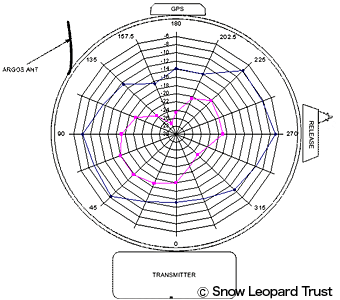Snow Leopard Update from Dr. Tom McCarthy: Discovering the cause of the previous difficulties
In November 2006, the Snow Leopard Trust initiated the first study of wild snow leopards using a GPS collar on a female leopard in Pakistan. Data from this study will help scientists understand and save these extremely rare, elusive cats. The GPS unit calculates the leopard's exact position three times a day, and then every two weeks the data is uploaded to the Argos satellite system and sent to researchers via email. Unfortunately, signals from the collar are being drowned out by background noise and have not been received by the Argos satellites. The problem still occurred after replacing the first collar, but we did manage to obtain some important GPS data from this study with the first collar: we learned that the female leopard spent much of her time in two parks in northwestern Pakistan. Additionally, a rare satellite uplink in May 2007 showed that she had ranged twenty miles away from her capture site and into Afghanistan!
The original collar is being tweaked in the lab in the hope of increasing the signal strength enough for it to be received 450 miles up in space. Placing a container of tissue equivalent liquid, or TEL, (47% sugar, 2% salt, 51% water) the same size as a snow leopard's neck in an anechoic test chamber, our resident electrical engineer has graphed the magnitude of attenuation (an average of 9-10 db) that came simply from the collar being placed on a living organism. The diagram below shows the collar's signal strength when placed around TEL, in blue, and when not placed around TEL, in pink. Attenuation of this degree is enough to blend the collar's signal into the background noise and prevent successful satellite uplinks.
Our engineer has also discovered that the direction of the collar's strongest signal is down into the earth. Therefore, changing the antenna's orientation may also be part of the answer. Other potential adjustments include playing with the antenna length or possibly adding a metal shield to the collar to minimize signal loss into the animals' tissue.

We had originally planned to collar four more cats in fall 2007, but political unrest in Pakistan has put our project on hold, incidentally allowing more time for collar experiments and potential improvements. We hope to begin capturing and collaring more snow leopards early in 2008. During the next field season, we are also considering testing a new collar technology that utilizes Globalstar satellite phone uplinks to transfer GPS data to researchers. This technology would eliminate the need for the satellites that our current collars are unable to contact reliably. Additional advantages to the satellite phone system are that two to four satellites are in view from any ground location at all times, and that GPS data is transmitted to the Internet in real time.
The female snow leopard's collar is programmed to fall off in January 2008, and we are waiting to collect it to obtain the full details of her journeys. It is interesting to note that the collared cat is the snow leopard that was featured in the "Mountains" segment of the Discovery Channel's "Planet Earth" miniseries.